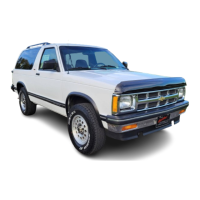Do you have a question about the Chevrolet 1994 Cavalier and is the answer not in the manual?
Explains how to use seats and safety belts properly, including child restraints.
Covers standard and optional features, starting, shifting, and braking.
Details operation of comfort systems and audio systems offered with the Chevrolet.
Provides information on driving on different roads and in various weather conditions.
Guides on what to do for common problems that can occur while driving.
Information on vehicle maintenance, fluids, lubricants, and appearance care.
Details required maintenance services and owner checks for vehicle upkeep.
Information on contacting Chevrolet for assistance, service publications, and safety defects.
Details on adjusting front seats, including manual adjustments and seatback recline.
Explains the importance and proper use of safety belts for all occupants.
Describes the driver's restraint system, including automatic lap-shoulder belts.
Provides guidance on correct safety belt usage for pregnant women.
Covers child restraints, including proper installation and use for infants and older children.
Information on ignition and door keys, including key codes and extra keys.
Details on how to lock and unlock doors from inside and outside the vehicle.
Explains how automatic door locks function and how to leave the vehicle.
Describes the remote trunk release mechanism and its lockout feature.
Advises on removing the ignition key and locking the steering wheel.
Details the five positions of the ignition switch and their functions.
Provides steps for starting the engine, including automatic and manual transaxles.
Explains the shift lever positions for automatic transaxles and their functions.
Describes the seven positions of the manual transaxle and shift patterns.
Instructions on how to set and release the parking brake lever.
Explains operation of manual and power windows, including driver's auto-down feature.
Details the functions of the turn signal lever, including headlights and cruise control.
Covers headlights, parking lights, fog lamps, and state/provincial regulations.
Explains control of windshield wipers, including intermittent and steady modes.
Details how to set, resume, increase, and decrease speed using cruise control.
Overview of instrument panel clusters, including indicator lights and gauges.
Explains how to read the speedometer and odometer for vehicle speed and distance.
Explains the function of the check engine light and what to do if it stays on.
Details the brake system warning light and its implications for vehicle safety.
Guides on controlling ventilation and heating using lever controls and fan speed.
Explains the air conditioner and heater settings, including MAX, VENT, and B/L modes.
Describes how to use the rear window defogger grid to remove fog from the rear window.
Offers tips for maintaining good ventilation and preventing window fogging.
Provides information on audio systems, including hearing damage prevention and added equipment.
Step-by-step guide to setting the vehicle's audio system clock.
Explains the AM/FM stereo radio controls, tuning, and station presets.
Details operation of the cassette player, including fast forward, reverse, and tape sides.
Covers the compact disc player controls, including track selection and playback modes.
Provides instructions for cleaning and maintaining the cassette tape player.
Emphasizes being prepared for unexpected situations and maintaining following distance.
Highlights the dangers of alcohol impairment and its effects on driving.
Explains braking action, perception time, reaction time, and stopping distances.
Describes how the ABS system works to prevent skidding and how to use it.
Provides guidance on evasive steering maneuvers to avoid collisions.
Offers tips for safely passing other vehicles on two-lane highways.
Explains the causes and handling of different types of skids.
Provides tips for safer driving during nighttime, including vision and glare management.
Advises on driving safely in wet conditions, including hydroplaning and brake effects.
Covers rules and advice for safe freeway driving, including merging and exiting.
Offers guidance on preparing for a long trip, including vehicle checks and rest.
Provides tips for driving on steep hills and mountains, including engine braking.
Offers advice for safe winter driving, including vehicle preparation and emergency supplies.
Details the correct procedure for towing the vehicle from the front using a tow truck.
Explains the function of hazard warning flashers for alerting others and indicating problems.
Provides essential safety steps for jump-starting a vehicle using jumper cables.
Guides on how to have the vehicle towed safely by a dealer or professional service.
Explains how to recognize and handle engine overheating, including steam from the engine.
Provides advice on what to expect and do if a tire blows out or leaks air slowly.
Details the steps for safely changing a flat tire using the vehicle's jacking equipment.
Information on the temporary use, inflation, and limitations of the compact spare tire.
Offers advice on how to get unstuck, including the 'rocking' method and caution.
General advice on vehicle service, recommending genuine GM parts and trained personnel.
Specifies recommended unleaded gasoline octane ratings and additives for optimal performance.
Guides on checking engine oil level, adding oil, and understanding oil types.
Details on selecting the correct oil viscosity and API certification for your vehicle.
Explains when to replace the air filter and the importance of keeping it in place.
Provides instructions for checking and adding automatic transaxle fluid.
Details on checking and adding fluid for the manual transaxle.
Information on the hydraulic clutch system, fluid checks, and what to use.
Explains the cooling system, coolant properties, and how to add coolant.
Guides on checking and adding power steering fluid, and what type to use.
Instructions on checking and adding windshield washer fluid.
Covers brake master cylinder, fluid, wear indicators, and pedal travel.
Information on the Delco Freedom battery and vehicle storage recommendations.
Step-by-step instructions for replacing headlight bulbs.
Detailed instructions for replacing taillight bulbs for different models.
Guide on how to remove and replace windshield wiper blades.
Critical information on vehicle weight limits, capacity, and proper cargo loading.
Advice on buying new tires, checking inflation, and understanding tire grading.
Explains the importance of wheel alignment and tire balance for performance.
Guidance on when and how to replace wheels, wheel bolts, and nuts.
Care instructions for aluminum wheels, advising against abrasive cleaners.
Tips for cleaning interior surfaces, including vinyl, fabric, and glass.
Information on Scotchgard™ fabric protection and general upholstery cleaning.
Guides for removing greasy/oily stains, non-greasy stains, and combination stains.
Instructions for cleaning vinyl surfaces with water, cleaner, and cloths.
Advice on cleaning instrument panel surfaces to avoid reflections and glare.
How to clean a cupholder that may have become clogged with spills.
Guidelines for cleaning glass, emphasizing non-abrasive cleaners and defogger protection.
How to clean the windshield and wiper blades to ensure visibility.
Best practices for washing the vehicle to preserve paint finish, avoiding harsh chemicals.
Advice on occasional waxing or polishing using non-abrasive products for a basecoat/clearcoat finish.
Cleaning recommendations for textured-surface bumper covers, avoiding abrasive materials.
Guidance on repairing stone chips, fractures, or deep scratches to prevent corrosion.
Importance of flushing underbody chemicals to prevent corrosion, especially in spring.
Information on chemical fallout damage and Chevrolet's repair policy.
Location and importance of the VIN for identifying the vehicle and its components.
Explains how the eighth VIN character identifies the engine and its specifications.
Location and helpfulness of the service parts label for ordering parts.
Warning against adding electrical equipment without dealer consultation to prevent damage.
Explains how fuses and circuit breakers protect the vehicle's wiring system.
Provides key fluid capacities and technical specifications for the vehicle's systems.
Lists recommended fluids and lubricants by item, application, GM part number, and size.
Lists bulb types and numbers for various exterior and interior lights.
Details engine specifications including VIN code, type, displacement, and firing order.
Lists recommended replacement parts for regular vehicle maintenance.
Introduction to vehicle maintenance, emphasizing its importance for safety and performance.
Highlights how proper maintenance contributes to environmental protection.
Explains the structure of the maintenance schedule section.
Guides users to choose between Schedule I and Schedule II based on driving conditions.
Details maintenance services and intervals for specific driving conditions (Schedule I).
Details maintenance services and intervals for less severe driving conditions (Schedule II).
Provides detailed explanations for each scheduled maintenance service item listed.
Lists checks and services owners should perform at fuel fill, monthly, and twice yearly.
Lists recommended fluids and lubricants with part numbers and specifications.
Provides a template for recording service dates, odometer readings, and maintenance performed.
Steps for resolving concerns with dealerships and contacting the Chevrolet Customer Assistance Center.
Information for owners with hearing or speech impairments to communicate with Chevrolet.
Details Chevrolet's voluntary participation in the BBB AUTO LINE for dispute resolution.
Instructions on how to report vehicle safety defects to NHTSA.
Instructions for reporting vehicle safety defects to Transport Canada.
How to report safety defects directly to General Motors customer assistance.
Information on the free roadside assistance program for Chevrolet owners.
Guidance on obtaining product service publications, bulletins, and indexes.
Information on Product Service Publications (PSP's) and how to order them.
Details on the quarterly published index for PSP's, including form numbers and prices.
Information on the content and availability of service manuals for diagnosis and repair.
Details on owner publications, including the Owner's Manual and Warranty Booklet.
Explains how to use seats and safety belts properly, including child restraints.
Covers standard and optional features, starting, shifting, and braking.
Details operation of comfort systems and audio systems offered with the Chevrolet.
Provides information on driving on different roads and in various weather conditions.
Guides on what to do for common problems that can occur while driving.
Information on vehicle maintenance, fluids, lubricants, and appearance care.
Details required maintenance services and owner checks for vehicle upkeep.
Information on contacting Chevrolet for assistance, service publications, and safety defects.
Details on adjusting front seats, including manual adjustments and seatback recline.
Explains the importance and proper use of safety belts for all occupants.
Describes the driver's restraint system, including automatic lap-shoulder belts.
Provides guidance on correct safety belt usage for pregnant women.
Covers child restraints, including proper installation and use for infants and older children.
Information on ignition and door keys, including key codes and extra keys.
Details on how to lock and unlock doors from inside and outside the vehicle.
Explains how automatic door locks function and how to leave the vehicle.
Describes the remote trunk release mechanism and its lockout feature.
Advises on removing the ignition key and locking the steering wheel.
Details the five positions of the ignition switch and their functions.
Provides steps for starting the engine, including automatic and manual transaxles.
Explains the shift lever positions for automatic transaxles and their functions.
Describes the seven positions of the manual transaxle and shift patterns.
Instructions on how to set and release the parking brake lever.
Explains operation of manual and power windows, including driver's auto-down feature.
Details the functions of the turn signal lever, including headlights and cruise control.
Covers headlights, parking lights, fog lamps, and state/provincial regulations.
Explains control of windshield wipers, including intermittent and steady modes.
Details how to set, resume, increase, and decrease speed using cruise control.
Overview of instrument panel clusters, including indicator lights and gauges.
Explains how to read the speedometer and odometer for vehicle speed and distance.
Explains the function of the check engine light and what to do if it stays on.
Details the brake system warning light and its implications for vehicle safety.
Guides on controlling ventilation and heating using lever controls and fan speed.
Explains the air conditioner and heater settings, including MAX, VENT, and B/L modes.
Describes how to use the rear window defogger grid to remove fog from the rear window.
Offers tips for maintaining good ventilation and preventing window fogging.
Provides information on audio systems, including hearing damage prevention and added equipment.
Step-by-step guide to setting the vehicle's audio system clock.
Explains the AM/FM stereo radio controls, tuning, and station presets.
Details operation of the cassette player, including fast forward, reverse, and tape sides.
Covers the compact disc player controls, including track selection and playback modes.
Provides instructions for cleaning and maintaining the cassette tape player.
Emphasizes being prepared for unexpected situations and maintaining following distance.
Highlights the dangers of alcohol impairment and its effects on driving.
Explains braking action, perception time, reaction time, and stopping distances.
Describes how the ABS system works to prevent skidding and how to use it.
Provides guidance on evasive steering maneuvers to avoid collisions.
Offers tips for safely passing other vehicles on two-lane highways.
Explains the causes and handling of different types of skids.
Provides tips for safer driving during nighttime, including vision and glare management.
Advises on driving safely in wet conditions, including hydroplaning and brake effects.
Covers rules and advice for safe freeway driving, including merging and exiting.
Offers guidance on preparing for a long trip, including vehicle checks and rest.
Provides tips for driving on steep hills and mountains, including engine braking.
Offers advice for safe winter driving, including vehicle preparation and emergency supplies.
Details the correct procedure for towing the vehicle from the front using a tow truck.
Explains the function of hazard warning flashers for alerting others and indicating problems.
Provides essential safety steps for jump-starting a vehicle using jumper cables.
Guides on how to have the vehicle towed safely by a dealer or professional service.
Explains how to recognize and handle engine overheating, including steam from the engine.
Provides advice on what to expect and do if a tire blows out or leaks air slowly.
Details the steps for safely changing a flat tire using the vehicle's jacking equipment.
Information on the temporary use, inflation, and limitations of the compact spare tire.
Offers advice on how to get unstuck, including the 'rocking' method and caution.
General advice on vehicle service, recommending genuine GM parts and trained personnel.
Specifies recommended unleaded gasoline octane ratings and additives for optimal performance.
Guides on checking engine oil level, adding oil, and understanding oil types.
Details on selecting the correct oil viscosity and API certification for your vehicle.
Explains when to replace the air filter and the importance of keeping it in place.
Provides instructions for checking and adding automatic transaxle fluid.
Details on checking and adding fluid for the manual transaxle.
Information on the hydraulic clutch system, fluid checks, and what to use.
Explains the cooling system, coolant properties, and how to add coolant.
Guides on checking and adding power steering fluid, and what type to use.
Instructions on checking and adding windshield washer fluid.
Covers brake master cylinder, fluid, wear indicators, and pedal travel.
Information on the Delco Freedom battery and vehicle storage recommendations.
Step-by-step instructions for replacing headlight bulbs.
Detailed instructions for replacing taillight bulbs for different models.
Guide on how to remove and replace windshield wiper blades.
Critical information on vehicle weight limits, capacity, and proper cargo loading.
Advice on buying new tires, checking inflation, and understanding tire grading.
Explains the importance of wheel alignment and tire balance for performance.
Guidance on when and how to replace wheels, wheel bolts, and nuts.
Care instructions for aluminum wheels, advising against abrasive cleaners.
Tips for cleaning interior surfaces, including vinyl, fabric, and glass.
Information on Scotchgard™ fabric protection and general upholstery cleaning.
Guides for removing greasy/oily stains, non-greasy stains, and combination stains.
Instructions for cleaning vinyl surfaces with water, cleaner, and cloths.
Advice on cleaning instrument panel surfaces to avoid reflections and glare.
How to clean a cupholder that may have become clogged with spills.
Guidelines for cleaning glass, emphasizing non-abrasive cleaners and defogger protection.
How to clean the windshield and wiper blades to ensure visibility.
Best practices for washing the vehicle to preserve paint finish, avoiding harsh chemicals.
Advice on occasional waxing or polishing using non-abrasive products for a basecoat/clearcoat finish.
Cleaning recommendations for textured-surface bumper covers, avoiding abrasive materials.
Guidance on repairing stone chips, fractures, or deep scratches to prevent corrosion.
Importance of flushing underbody chemicals to prevent corrosion, especially in spring.
Information on chemical fallout damage and Chevrolet's repair policy.
Location and importance of the VIN for identifying the vehicle and its components.
Explains how the eighth VIN character identifies the engine and its specifications.
Location and helpfulness of the service parts label for ordering parts.
Warning against adding electrical equipment without dealer consultation to prevent damage.
Explains how fuses and circuit breakers protect the vehicle's wiring system.
Provides key fluid capacities and technical specifications for the vehicle's systems.
Lists recommended fluids and lubricants by item, application, GM part number, and size.
Lists bulb types and numbers for various exterior and interior lights.
Details engine specifications including VIN code, type, displacement, and firing order.
Lists recommended replacement parts for regular vehicle maintenance.
Introduction to vehicle maintenance, emphasizing its importance for safety and performance.
Highlights how proper maintenance contributes to environmental protection.
Explains the structure of the maintenance schedule section.
Guides users to choose between Schedule I and Schedule II based on driving conditions.
Details maintenance services and intervals for specific driving conditions (Schedule I).
Details maintenance services and intervals for less severe driving conditions (Schedule II).
Provides detailed explanations for each scheduled maintenance service item listed.
Lists checks and services owners should perform at fuel fill, monthly, and twice yearly.
Lists recommended fluids and lubricants with part numbers and specifications.
Provides a template for recording service dates, odometer readings, and maintenance performed.
Steps for resolving concerns with dealerships and contacting the Chevrolet Customer Assistance Center.
Information for owners with hearing or speech impairments to communicate with Chevrolet.
Details Chevrolet's voluntary participation in the BBB AUTO LINE for dispute resolution.
Instructions on how to report vehicle safety defects to NHTSA.
Instructions for reporting vehicle safety defects to Transport Canada.
How to report safety defects directly to General Motors customer assistance.
Information on the free roadside assistance program for Chevrolet owners.
Guidance on obtaining product service publications, bulletins, and indexes.
Information on Product Service Publications (PSP's) and how to order them.
Details on the quarterly published index for PSP's, including form numbers and prices.
Information on the content and availability of service manuals for diagnosis and repair.
Details on owner publications, including the Owner's Manual and Warranty Booklet.
| Brand | Chevrolet |
|---|---|
| Model | 1994 Cavalier |
| Category | Automobile |
| Language | English |











